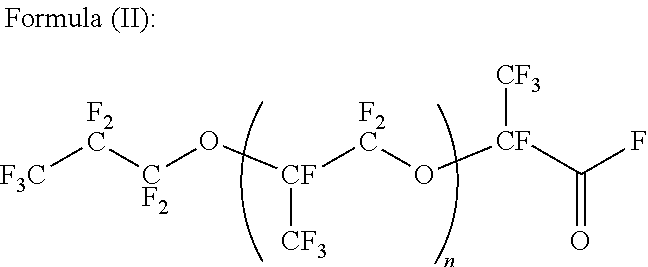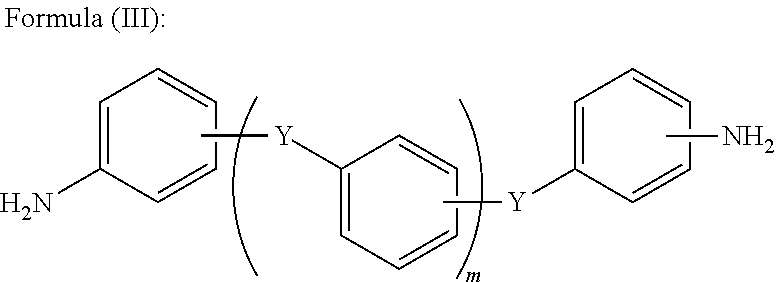Lubricant Composition
a technology of lubricant composition and composition, applied in the field of lubricant composition, to achieve the effect of excellent stabilzability (anti-degradation property, excellent rust prevention property, excellent stability
- Summary
- Abstract
- Description
- Claims
- Application Information
AI Technical Summary
Benefits of technology
Problems solved by technology
Method used
Image
Examples
example 1
[0121]10.1 g of 1,4-bis(4-aminophenoxy)benzene was dissolved in a mixed solvent of 100 ml of pyridine and 100 ml of AK-225 (mixture of CF3CF2CHCl2 and CClF2CF3CHClF), followed by slow dropping of 209.0 g of acid fluoride (n=11) at a room temperature, and by stirring overnight under a condition ranging from the room temperature to 40° C.
[0122]50 ml of methanol was added and stirred, followed by subsequent neutralization with a saturated NaHCO3 water solution.
[0123]The reaction product was extracted by AK-225 (mixture of CF3CF2CHCl2 and CClF2CF3CHClF), and washed by a saturated NaCl water solution. The AK-225 was distilledly removed by an evaporator, to obtain a light yellow and highly viscous liquid (C-2).
[0124]With analysis of a chemical structure of C-2 by NMR, it was revealed that it had a structure of Formula (I), and n=11, m=1, and k=3. In view of the starting materials of synthesis, Y is supposed to be O (oxygen atom).
[0125]10 g of the obtained light yellow and highly viscous l...
example 2
[0128]10.1 g of 1,4-bis(4-aminophenoxy)benzene was dissolved in a mixed solvent of 100 ml of pyridine and 100 ml of AK-225, followed by slow dropping of 101.0 g of acid fluoride (n=40) at a room temperature, and by stirring overnight under a condition ranging from the room temperature to 40° C.
[0129]50 ml of methanol was added and stirred, followed by subsequent neutralization with a saturated NaHCO3 water solution.
[0130]The reaction product was extracted by AK-225, and washed by a saturated NaCl water solution. The AK-225 was distilledly removed by an evaporator, to obtain a light yellow and highly viscous liquid (C-3).
[0131]With analysis of a chemical structure of C-3 by NMR, it was revealed that it had a structure of Formula (I), and n=40, m=1, and k=3. In view of the starting materials of synthesis, Y is supposed to be O (oxygen atom).
[0132]1 g of the obtained light yellow and highly viscous liquid (C-3) was added into 199 g of the base oil (A-1) used in Example 1, followed by s...
example 3
[0134]3 g of bis[4-(aminophenoxy)phenyl]sulfone was dissolved in a mixed solvent of 100 ml of pyridine and 100 ml of AK-225, followed by slow dropping of 209.0 g of acid fluoride (n=11) at a room temperature, and by stirring overnight under a condition ranging from the room temperature to 40° C.
[0135]50 ml of methanol was added and stirred, followed by subsequent neutralization with a saturated NaHCO3 water solution.
[0136]The reaction product was extracted by AK-225, and washed by a saturated NaCl water solution. The AK-225 was distilledly removed by an evaporator, to obtain a light yellow and highly viscous liquid (C-4).
[0137]With analysis of a chemical structure of C-4 by NMR, it was revealed that it had a structure of Formula (I), and n=11, m=2, and k=3. In view of the starting materials of synthesis, Y's are supposed to be an SO2 group and O (oxygen atom).
[0138]6 g of the obtained light yellow and highly viscous liquid (C-4) was added into 194 g of the base oil (A-1) used in Exa...
PUM
| Property | Measurement | Unit |
|---|---|---|
| kinematic viscosity | aaaaa | aaaaa |
| average primary particle diameter | aaaaa | aaaaa |
| averaged primary particle diameter | aaaaa | aaaaa |
Abstract
Description
Claims
Application Information
 Login to View More
Login to View More - R&D
- Intellectual Property
- Life Sciences
- Materials
- Tech Scout
- Unparalleled Data Quality
- Higher Quality Content
- 60% Fewer Hallucinations
Browse by: Latest US Patents, China's latest patents, Technical Efficacy Thesaurus, Application Domain, Technology Topic, Popular Technical Reports.
© 2025 PatSnap. All rights reserved.Legal|Privacy policy|Modern Slavery Act Transparency Statement|Sitemap|About US| Contact US: help@patsnap.com



